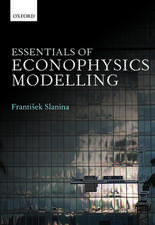Physical Applications of Homogenenous Balls: Progress in Mathematical Physics, cartea 40
Autor Yaakov Friedman, Y. Friedmanen Limba Engleză Hardback – 30 noi 2004
Din seria Progress in Mathematical Physics
-
 Preț: 377.18 lei
Preț: 377.18 lei -
 Preț: 398.92 lei
Preț: 398.92 lei -
 Preț: 395.25 lei
Preț: 395.25 lei -
 Preț: 391.02 lei
Preț: 391.02 lei -
 Preț: 396.62 lei
Preț: 396.62 lei -
 Preț: 396.62 lei
Preț: 396.62 lei - 20%
 Preț: 481.50 lei
Preț: 481.50 lei -
 Preț: 399.29 lei
Preț: 399.29 lei -
 Preț: 391.02 lei
Preț: 391.02 lei -
 Preț: 381.98 lei
Preț: 381.98 lei - 18%
 Preț: 1239.85 lei
Preț: 1239.85 lei - 18%
 Preț: 1118.93 lei
Preț: 1118.93 lei - 15%
 Preț: 649.87 lei
Preț: 649.87 lei - 15%
 Preț: 575.10 lei
Preț: 575.10 lei - 18%
 Preț: 786.18 lei
Preț: 786.18 lei - 15%
 Preț: 656.10 lei
Preț: 656.10 lei -
 Preț: 395.25 lei
Preț: 395.25 lei -
 Preț: 382.18 lei
Preț: 382.18 lei - 15%
 Preț: 648.56 lei
Preț: 648.56 lei - 15%
 Preț: 649.06 lei
Preț: 649.06 lei - 15%
 Preț: 645.60 lei
Preț: 645.60 lei -
 Preț: 392.21 lei
Preț: 392.21 lei - 15%
 Preț: 595.86 lei
Preț: 595.86 lei -
 Preț: 409.13 lei
Preț: 409.13 lei - 15%
 Preț: 690.62 lei
Preț: 690.62 lei - 15%
 Preț: 704.69 lei
Preț: 704.69 lei - 15%
 Preț: 654.43 lei
Preț: 654.43 lei - 15%
 Preț: 646.30 lei
Preț: 646.30 lei -
 Preț: 398.35 lei
Preț: 398.35 lei -
 Preț: 402.76 lei
Preț: 402.76 lei -
 Preț: 388.72 lei
Preț: 388.72 lei - 18%
 Preț: 781.62 lei
Preț: 781.62 lei -
 Preț: 408.16 lei
Preț: 408.16 lei -
 Preț: 391.79 lei
Preț: 391.79 lei
Preț: 588.50 lei
Preț vechi: 692.36 lei
-15% Nou
Puncte Express: 883
Preț estimativ în valută:
112.64€ • 122.40$ • 94.68£
112.64€ • 122.40$ • 94.68£
Carte tipărită la comandă
Livrare economică 21 aprilie-05 mai
Preluare comenzi: 021 569.72.76
Specificații
ISBN-13: 9780817633394
ISBN-10: 0817633391
Pagini: 279
Dimensiuni: 157 x 236 x 18 mm
Greutate: 0.54 kg
Ediția:1983. Softcover
Editura: BIRKHAUSER BOSTON INC
Seria Progress in Mathematical Physics
Locul publicării:Boston, MA, United States
ISBN-10: 0817633391
Pagini: 279
Dimensiuni: 157 x 236 x 18 mm
Greutate: 0.54 kg
Ediția:1983. Softcover
Editura: BIRKHAUSER BOSTON INC
Seria Progress in Mathematical Physics
Locul publicării:Boston, MA, United States
Public țintă
ResearchCuprins
* Preface
* List of Figures
* List of Tables
* Relativity Based on Symmetry
* The Real Spin Domain
* The Complex Spin Factor and Applications
* The Classical Bounded Symmetric Domains
* The Algebraic Structure of Homogeneous Balls
* Classification of JBW*-triple Factors
* References
* Index
* List of Figures
* List of Tables
* Relativity Based on Symmetry
* The Real Spin Domain
* The Complex Spin Factor and Applications
* The Classical Bounded Symmetric Domains
* The Algebraic Structure of Homogeneous Balls
* Classification of JBW*-triple Factors
* References
* Index
Recenzii
From the reviews:
"The aim of this book is to present the theory of Jordan algebraic structures (Jordan triple systems) and their geometric counterpart, the so-called homogeneous balls, from the point of view of applications ot mathematical physics: special relativity, spinors and foundational quantum mechanics...The (senior) author has made important research contributions to all three areas described above, and the exposition of the theory and the applications is very careful. This makes the book suitable both for experts and non-experts interested in the applications." ---Mathematical Reviews
"This fine book provides a highly original approach to theoretical physics, its contents reflecting the author's and his ollaborators' copious contributions to many branches of mathematics and physics over the past years."(ZENTRALBLATT MATH)
"The aim of this book is to present the theory of Jordan algebraic structures (Jordan triple systems) and their geometric counterpart, the so-called homogeneous balls, from the point of view of applications ot mathematical physics: special relativity, spinors and foundational quantum mechanics...The (senior) author has made important research contributions to all three areas described above, and the exposition of the theory and the applications is very careful. This makes the book suitable both for experts and non-experts interested in the applications." ---Mathematical Reviews
"This fine book provides a highly original approach to theoretical physics, its contents reflecting the author's and his ollaborators' copious contributions to many branches of mathematics and physics over the past years."(ZENTRALBLATT MATH)
Descriere
This work introduces a unifying mathematical model to describe phenomena in different branches of physics. In particular, the book develops the algebraic structure of bounded symmetric domains, highlighting the symmetry of physical laws and focusing on the interplay between algebraic structures (such as triple products) and the geometry of the domain. The resulting mathematical tools have a number of physical applications. The book's careful development of the topic and its emphasis on mathematics and physics make it useful for graduate students and researchers in both disciplines.














